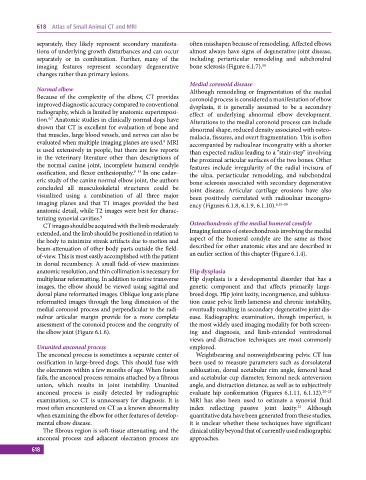Page 628 - Atlas of Small Animal CT and MRI
P. 628
618 Atlas of Small Animal CT and MRI
separately, they likely represent secondary manifesta often misshapen because of remodeling. Affected elbows
tions of underlying growth disturbances and can occur almost always have signs of degenerative joint disease,
separately or in combination. Further, many of the including periarticular remodeling and subchondral
imaging features represent secondary degenerative bone sclerosis (Figure 6.1.7). 14
changes rather than primary lesions.
Medial coronoid disease
Normal elbow Although remodeling or fragmentation of the medial
Because of the complexity of the elbow, CT provides coronoid process is considered a manifestation of elbow
improved diagnostic accuracy compared to conventional dysplasia, it is generally assumed to be a secondary
radiography, which is limited by anatomic superimposi effect of underlying abnormal elbow development.
tion. Anatomic studies in clinically normal dogs have Alterations to the medial coronoid process can include
6,7
shown that CT is excellent for evaluation of bone and abnormal shape, reduced density associated with osteo
that muscles, large blood vessels, and nerves can also be malacia, fissures, and overt fragmentation. This is often
8
evaluated when multiple imaging planes are used. MRI accompanied by radioulnar incongruity with a shorter
is used extensively in people, but there are few reports than expected radius leading to a “stair‐step” involving
in the veterinary literature other than descriptions of the proximal articular surfaces of the two bones. Other
the normal canine joint, incomplete humeral condyle features include irregularity of the radial incisura of
ossification, and flexor enthesiopathy. 9–13 In one cadav the ulna, periarticular remodeling, and subchondral
eric study of the canine normal elbow joint, the authors bone sclerosis associated with secondary degenerative
concluded all musculoskeletal structures could be joint disease. Articular cartilage erosions have also
visualized using a combination of all three major been positively correlated with radioulnar incongru
imaging planes and that T1 images provided the best ency (Figures 6.1.8, 6.1.9, 6.1.10). 6,15–19
anatomic detail, while T2 images were best for charac
terizing synovial cavities. 9
CT images should be acquired with the limb moderately Osteochondrosis of the medial humeral condyle
extended, and the limb should be positioned in relation to Imaging features of osteochondrosis involving the medial
the body to minimize streak artifacts due to motion and aspect of the humeral condyle are the same as those
beam‐attenuation of other body parts outside the field‐ described for other anatomic sites and are described in
of‐view. This is most easily accomplished with the patient an earlier section of this chapter (Figure 6.1.4).
in dorsal recumbency. A small field‐of‐view maximizes
anatomic resolution, and thin collimation is necessary for Hip dysplasia
multiplanar reformatting. In addition to native transverse Hip dysplasia is a developmental disorder that has a
images, the elbow should be viewed using sagittal and genetic component and that affects primarily large‐
dorsal plane reformatted images. Oblique long axis plane breed dogs. Hip joint laxity, incongruence, and subluxa
reformatted images through the long dimension of the tion cause pelvic limb lameness and chronic instability,
medial coronoid process and perpendicular to the radi eventually resulting in secondary degenerative joint dis
oulnar articular margin provide for a more complete ease. Radiographic examination, though imperfect, is
assessment of the coronoid process and the congruity of the most widely used imaging modality for both screen
the elbow joint (Figure 6.1.6). ing and diagnosis, and limb‐extended ventrodorsal
views and distraction techniques are most commonly
Ununited anconeal process employed.
The anconeal process is sometimes a separate center of Weightbearing and nonweightbearing pelvic CT has
ossification in large‐breed dogs. This should fuse with been used to measure parameters such as dorsolateral
the olecranon within a few months of age. When fusion subluxation, dorsal acetabular rim angle, femoral head
fails, the anconeal process remains attached by a fibrous and acetabular cup diameter, femoral neck anteversion
union, which results in joint instability. Ununited angle, and distraction distance, as well as to subjectively
anconeal process is easily detected by radiographic evaluate hip conformation (Figures 6.1.11, 6.1.12). 20–25
examination, so CT is unnecessary for diagnosis. It is MRI has also been used to estimate a synovial fluid
most often encountered on CT as a known abnormality index reflecting passive joint laxity. Although
23
when examining the elbow for other features of develop quantitative data have been generated from these studies,
mental elbow disease. it is unclear whether these techniques have significant
The fibrous region is soft‐tissue attenuating, and the clinical utility beyond that of currently used radiographic
anconeal process and adjacent olecranon process are approaches.
618

